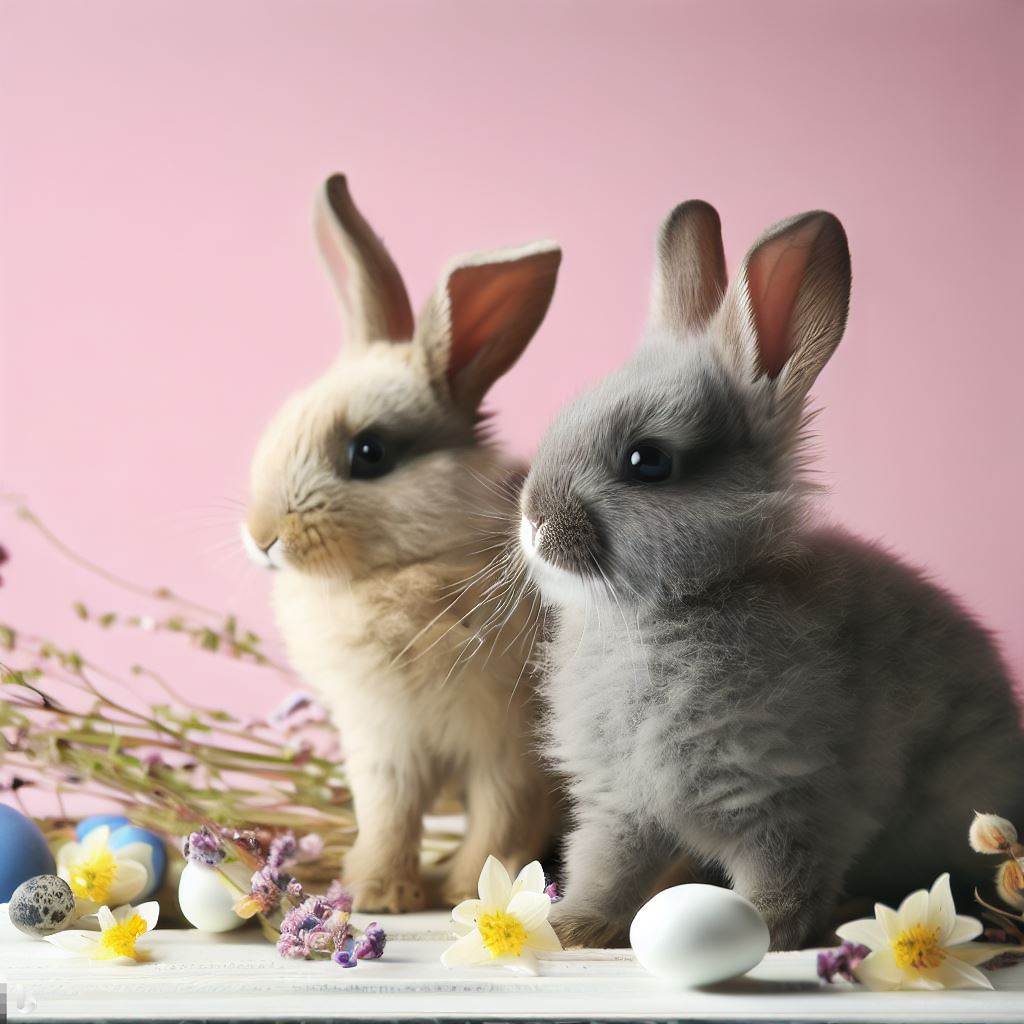Last updated on July 14th, 2023 at 05:21 pm
Why Rabbits For Easter? Exploring the Symbolism and Tradition Behind Easter Bunny
Introduction
Many people worldwide celebrate Easter because it is a national holiday with significant cultural and religious significance. Easter is primarily associated with the resurrection of Jesus Christ, but it has become associated with several traditions and symbols. One of those symbols is the Rabbit, often portrayed as the Easter Bunny. In this article, we explore the historical, cultural, and symbolic aspects that have contributed to rabbits’ presence during Easter, which explores the origins and reasons behind this association.
Why Rabbits For Easter?
The association between rabbits and Easter is rooted in pagan and Christian traditions.
The Rabbit was associated with fertility and spring in pagan mythology due to its ability to reproduce quickly and its connection to the Earth’s renewal.
As Christianity spread, pagan customs and symbols were incorporated into its celebrations to ease the transition for new converts. As a result, the Rabbit’s symbolism was assimilated into Easter celebrations.
Christian Easter commemorates the resurrection of Christ after his crucifixion. Easter coincides with the arrival of spring, a time of rebirth and new beginnings. Easter may have been associated with the rejuvenation of nature, which is why rabbits were adopted as Easter symbols.
Rabbits are also known for reproducing prolifically, aligning with Easter, which is associated with new life and fertility. Eggs, too, became associated with new life and fertility, as they are symbols of egg birth.
In Western culture, particularly in the United States, the Easter Bunny became famous as a rabbit who delivered eggs to children over time. It has become a widespread custom for children to hunt for Easter eggs decorated and filled with treats.

Historical Origins
Pre-Christian cultures associated rabbits with fertility and spring, symbolizing new life, growth, and abundance. The connection between rabbits and Easter dates back thousands of years. This association with fertility and rebirth was quickly incorporated into Easter’s festivities because it falls during spring.

Pagan Influences
The Easter holiday also incorporates elements from pagan traditions. This pagan festival celebrates the arrival of spring and the fertility of the Earth, also known as Eostre. As a symbol of fertility and new beginnings, the hare, a close relative of the Rabbit, was revered during this festival. Eventually, the pagan beliefs merged with Christian beliefs, which led to the association between rabbits and Easter.

Symbolism of Rabbits
A rabbit’s ability to reproduce rapidly has long been associated with prolific breeding, reinforcing their symbolism of fertility, abundance, and regeneration. Easter is a time of spiritual and physical renewal, and thus its symbolic representation of rabbits aligns well with its themes of rebirth and joy.

The Legend of the Easter Bunny
In German folklore, the Easter Bunny, or Easter Hare, gained popularity during the Middle Ages as a gift-giving animal. Children who behaved well would receive colourful eggs from the Easter Bunny. Eventually, German immigrants brought egg-laying rabbits to America in the 18th century, making them an integral part of Easter celebrations worldwide.

Exploring the Symbolism of Rabbits during Easter
The significance of rabbits during Easter is deeply rooted in various cultural and religious traditions. Often depicted as cute and cuddly, Rabbits have become closely associated with the holiday.
Here are some interpretations of the symbolism of rabbits during Easter
Fertility and New Life
A rabbit’s prolific breeding habits align with the Easter theme of fertility and new life since they are associated with fertility and new life. Easter celebrates Jesus Christ’s resurrection and the promise of new life. Rabbits symbolize renewal and the cycle of life through their ability to reproduce abundantly.
Pagan Origins
Pagan traditions and the spring equinox celebration can be traced back to rabbit symbolism during Easter. Rabbits are associated with Eostre, the Germanic goddess of fertility and spring. Symbols of Eostre included hares and eggs, which eventually merged with Christian Easter celebrations.
Christian Symbolism
Christians often see rabbits as symbols of purity and innocence. A rabbit’s gentle nature and soft appearance can represent the qualities of grace and gentleness. Children often participate in Easter egg hunts and receive chocolate rabbits as treats. They are associated with joy and innocence.
Resurrection and Rebirth
As a result of their ability to burrow into the ground and create underground tunnels and nests, rabbits are often associated with rebirth and resurrection. Just as Jesus emerged from the tomb after his crucifixion, rabbits emerged from their burrows to represent new beginnings and victory over death.
Seasonal Symbol
Rabbits returning to fields and meadows after the cold winter months can symbolize the arrival of spring and nature’s renewal at Easter when it falls in the spring season in the Northern Hemisphere.
It’s important to note that the symbolism of rabbits during Easter may vary across different cultures and individuals. While some see them as significant symbols, others may appreciate them as a whimsical and festive holiday representation.
Understanding the Role of Rabbits in Easter Traditions
Easter traditions have been linked with rabbits for many years, particularly in Western cultures. Although the association between rabbits and Easter may seem perplexing at first glance, it has historical and symbolic roots.
An ancient pagan festival celebrating the arrival of spring may be responsible for the connection between rabbits and Easter. As rabbits are known for their rapid reproduction and association with fertility, they became associated with these springtime celebrations. These festivities often honoured Eostre, a goddess of fertility and new beginnings.
To facilitate the conversion of local populations, Christianity often incorporated and adapted existing traditions and symbols as they spread across Europe. The Christian holiday Easter, which commemorates Christ’s resurrection, became intertwined with the symbolism of rabbits as fertility creatures.
Symbolically, Easter represents rebirth and new life in Christianity. The resurrection of Jesus symbolizes a triumph over death and the possibility of spiritual renewal for believers. This theme of new life and rebirth is echoed by the association of rabbits with fertility.
The Easter Bunny developed over time, especially in German folklore. According to this tradition, the Easter Bunny delivered colourful eggs on Easter Sunday to well-behaved children. Children often decorated and hid the eggs, symbolizing new life and resurrection.
Through German immigrants in the 18th and 19th centuries, the Easter Bunny tradition spread to other countries, including the United States. In many parts of the world, children participate in Easter egg hunts to find hidden eggs left by the Easter Bunny.
There may be differences in the origins of the Easter Bunny and its association with rabbits across cultures. Still, the overarching themes of rebirth, fertility, and new life remain the same. Easter symbolizes joy and hopes through rabbits, which have become an enduring symbol.
It’s worth noting that Easter traditions may vary across regions and cultures. Some traditions focus more on religious aspects, while others emphasize secular customs such as egg hunts and the presence of the Easter Bunny. Nonetheless, the role of rabbits in Easter traditions reflects the rich tapestry of cultural influences and symbolic meanings associated with this holiday.

What does the Easter Bunny have to do with Jesus?
There is no direct connection between the Easter Bunny and Jesus in the Christian tradition since the bunny represents secular Easter celebrations, particularly in Western cultures. In contrast, Jesus represents Easter’s religious significance.
What is the dark history of the Easter Bunny?
Originally, it was associated with fertility symbols and German folklore, but its modern depiction is mainly associated with fun and joyous Easter celebrations.
Where did the Easter Bunny originate?
Many sources contributed to the origins of the Easter Bunny. It has roots in pagan celebrations of spring and fertility, such as the Germanic goddess Eostre. Throughout history, these traditions merged with Christian Easter celebrations, especially in Germany and other parts of Europe.
What do Easter eggs represent in Christianity?
In Christianity, Easter eggs represent new life and resurrection. The egg is a powerful symbol of rebirth and renewal, aligned with Jesus’ resurrection. It serves as a visual reminder of Easter’s central message.
Why is it the Easter Bunny and not a chicken?
Bunnies and eggs have long been associated with springtime fertility and new life, which aligns with Easter themes, so people choose the Easter Bunny over chickens. Despite being associated with eggs, chickens and hens may not have the same cultural significance during Easter.
Why does the Easter Bunny lay eggs?
This concept is a blend of various traditions and needs a logical explanation. It is simply a whimsical aspect of the mythology surrounding the Easter Bunny.
Is the Easter Bunny evil?
No, the Easter Bunny is not considered evil. In popular culture, the Easter Bunny is portrayed as a joyful and benevolent character who brings treats and gifts to children during Easter. It is associated with fun and happiness rather than evil or malevolence.
Is the Easter Bunny’s origin pagan?
Yes, the origin of the Easter Bunny can be traced back to pagan traditions. The celebration of spring and fertility, which included symbols like bunnies and eggs, predates Christianity. With the spread of Christianity, these pagan traditions merged with the Christian celebration of Easter, incorporating the Easter Bunny into modern Easter festivities.
conclusion
Rabbits have been associated with Easter for a long time and have been influenced by various factors. The Rabbit, often depicted as a symbol of fertility and new life, aligns with themes of rebirth and renewal central to Easter’s Christian celebration. The Rabbit’s prolific breeding habits have also heightened its association with fertility and abundance. It is unclear what the origins of the rabbit-Easter connection are, but it has become an integral part of Easter celebrations in many cultures. During Easter, rabbits have come to symbolize joy, playfulness, and spring, whether through religious symbolism or popular culture.
